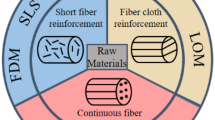Abstract
Flame retardant additives offer a potential short-term solution for reducing the combustibility of composites, and hence the reduction of the associated hazards. A brief review of fire modelling was performed to identify suitable mathematical expressions with which the results of the experimental flame retardant investigation were analysed. These were then used in a limited trial to compare the experimental and calculated ignition parameters. The comparison of simple mathematical equations with fire test results indicated that their ability to reasonably reproduce the experimental ignition parameters of the flame retardant treated composites is dependent on the mechanism of flame retardant activity, particularly the stage of combustion at which it is designed to be active.
Similar content being viewed by others
References
E. L. Morrey, Potential hazards associated with combustion of polymer composite materials, and strategies for their mitigation. DERA/MSS/MSFC4/JP010499. Centre for Composite Materials. Imperial College of Science, Technology and Medicine, April 2001.
V. Babrauskas and S. J. Grayson, Heat release in fires. E and FN SPON, Chapman and Hall, 1992.
V. Babrauskas and S. J. Grayson, (Eds), Heat release in fires. Elsevier Applied Science, 1992.
S. B. Martin, Prediction of ignition thresholds during ramp heating. Behaviour of polymeric materials in fire. ASTM Special Technical Publication 816, 1982.
A. F. Grand, The use of the cone calorimeter to assess the effectiveness of flame retardant polymers under simulated real fire test conditions. Interflam '96 Proceedings. Interscience Communications Ltd., 1996.
University of Leeds, Polymers and textiles in fires, short course lecture notes. Department of Fuel and Energy. 27–29 October 1998.
F. L. Matthews and R. D. Rawlings, Composite materials: engineering and science, Chapman and Hall 1995.
ISO 5660 Pt.1. Rate of Heat Release From Building Products (Cone Calorimeter Method). International Standards organisation, 1993.
BS 903: Part A1: 1996 Determination of Density. British Standards Institute.
K. L. Ramakumar, J. Therm. Anal. Cal., 66 (2001) 387.
Z. Jiang, J. Therm. Anal. Cal., 64 (2001) 85.
K. Shinzato and T. Baba, J. Therm. Anal. Cal., 64 (2001) 413.
V. Roháč, J. Therm. Anal. Cal., 70 (2002) 455.
H.-G. Lipovská, J. Therm. Anal. Cal., 68 (2002) 753.
G. De Domenico, J. Therm. Anal. Cal., 66 (2001) 815.
Encyclopaedia of Polymer Science and Engineering, Flammability. Vol. 7. John Wiley and Sons, 1987, pp. 154-210.
R. E. Myers and E. Licursi, J. Fire Sciences, Vol. 3. Nov/Dec, 1985.
R. V. Petrella, Proceedings Fire Retardant Chemical Association Fall Conference 1986. Fire Retardant Chemical Association, pp. 121-131.
E. D. Weil, Mechanisms of phosphorus-based flame retardants. Proceedings Fire Retardant Chemical Association Spring Conference 1992. Fire Retardant Chemical Association, pp. 19-32.
J. Kersjes, Flame retardant mechanistic aspects of melamine cyanurate in polyamide 6 and 66. Conference Proceedings Interflam 1999. Interscience Communications.
P. M. Cook and L. L. Musselman, Mechanisms and performance of molybdenum, tin, zinc and boron additives and comparative flammability and smoke results in halogenated polymers including wire and cable products. Conference proceedings Flame Retardants 2000. Interscience Communications, 2000.
D. M. Schubert and R. M. Leeuwendal, The use of a new zinc borate as a flame retardant synergist in engineering plastics. Conference proceedings Flame Retardants 1998. Interscience Communications, 1998.
Author information
Authors and Affiliations
Rights and permissions
About this article
Cite this article
Morrey, E.L. Flame retardant composite materials. Journal of Thermal Analysis and Calorimetry 72, 943–954 (2003). https://doi.org/10.1023/A:1025086703140
Issue Date:
DOI: https://doi.org/10.1023/A:1025086703140




